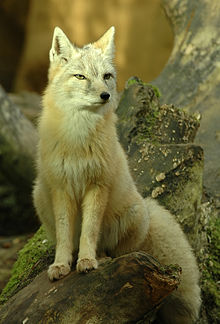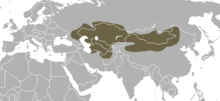- Corsac fox
-
Corsac fox[1] 
Conservation status Scientific classification Kingdom: Animalia Phylum: Chordata Class: Mammalia Order: Carnivora Family: Canidae Genus: Vulpes Species: V. corsac Binomial name Vulpes corsac
Linnaeus, 1768
Corsac range The corsac fox (Vulpes corsac), also known as the steppe fox, is a medium sized Asiatic fox species found throughout the central steppes of Asia. It is sometimes referred to as the "sand fox", but this terminology is confusing because two other species, the Tibetan sand fox and Rüppell's fox are also sometimes known by this name. The corsac fox is threatened by hunting for the fur trade.
Contents
Description
The corsac fox is a medium-sized fox, with a head and body length of 45 to 65 centimetres (18 to 26 in), and a tail 19 to 35 centimetres (7.5 to 14 in) long. Adults weigh from 1.6 to 3.2 kilograms (3.5 to 7.1 lb). It has grey to yellowish fur over much of the body, with paler underparts and pale markings on the mouth, chin, and throat. During the winter, the coat becomes much thicker and more silky in texture, and is straw-grey in colour, with a darker line running down the back.[3]
For a fox, it has small teeth and a wide skull. It has hooked claws and can climb trees.[citation needed] It is reported to have keen eyesight and hearing and an acute sense of smell. It has a number of scent glands, some of which produce pungent odours[4], although not as extreme as those found in some other Vulpes species. The glands are found in the anal region, above the base of the tail, and on the paws and cheeks.[3]
Corsac foxes are reported to bark during hunting or when threatening rivals, and to use higher pitch yelps or chirps as alarm calls or social greetings.[3]
Distribution and habitat
Corsac foxes live in the steppes and semi-desert of central and northeast Asia. They are found throughout Kazakhstan, Uzbekistan, and Turkmenistan, and through all except the northernmost regions of Mongolia. In the south, their range extends into the more northern parts of Iran, Tajikistan, Kyrgyzstan, Afghanistan, and China, and they can also be found in neighbouring regions of Russia.[2]
Three subspecies are currently recognised[3]:
- Vulpes corsac corsac - northern Kazakhstan, southern Siberia
- Vulpes corsac kalmykorum - northern Uzbekistan, Caucasus
- Vulpes corsac turkmenicus - southern Uzbekistan, Turkmenistan, China, Mongolia, and neighbouring regions
These foxes inhabit open grassy steppes and semi-deserts, and avoid dense vegetation and mountainous regions.[2] True deserts with drifting sands are also avoided, as are snowfields more than about 15 centimetres (6 in) deep.[5] Corsac foxes generally stay far away from human disturbance.
Ecology and behavior
As an adaption to the arid climate they live in, corsac foxes need little water to survive, obtaining most of the moisture they need from their food. Their diet consists mainly of insects and small rodents, such as voles, gerbils, jerboas, hamsters, and ground squirrels. They may also eat larger prey from time to time, including hares and pikas, and will scavenge for carrion and human refuse. Although predominantly carnivorous, they do occasionally eat fruit and other vegetation, especially when animal prey are scarce. Natural predators of corsac foxes include wolves, eagles, buzzards, and eagle-owls.[3]
Corsac Foxes are nocturnal and nomadic hunters of the steppes. They do not have a defended territory, and unlike some foxes, will sometimes form packs. Because they cannot hunt in deep snow, they will either shelter in their dens during harsh weather, or, in the northern parts of their range, they may migrate up to 600 kilometres (370 mi) south in the winter. They have been reported to follow herds of local antelope, relying on them to compress the snow as they pass.[3]
Their prey is often buried in caches.[citation needed]
Corsac foxes shelter in burrows from harsh weather and larger predators. Although they can dig their own dens, these are generally shallow, and they often take over the burrows of other animals, such as marmots, ground squirrels, or badgers. Dens may have several entrances, but are usually less than 1 metre (3 ft 3 in) deep.[3] The burrow is shared between the social packs, with several dens and connecting holes.
Corsac foxes are excellent climbers, but are rather slow runners and could be caught easily by a dog.[citation needed] While they are reported to be nocturnal in the wild, in captivity they are very active during the day. This can be explained by increasing human disturbances, causing them to become active at night to avoid humans.[citation needed]
Reproduction
The mating season starts in January and ends in March. Males will initially fight for access to females, but eventually establish a monogamous bond, and assist in the raising of their young. The mother initially creates a birthing den, which is sometimes shared with other pregnant females, but moves her young to new burrows several times after they are born.[3]
Typically, two to six young are born after a gestation period of 52 to 60 days, although there are reported cases of ten pups being born in a single litter. Newborn kits weigh around 60 grams (2.1 oz), and have fluffy light brown fur that turns yellowish as they age. They are born blind, and open their eyes at around two weeks of age; they begin to eat meat at four weeks, and emerge from the den shortly after. Corsax foxes reach sexual maturity within nine to ten months and reproduce in the second year of life.[5] They live up to nine years in the wild.[3]
Evolution
The corsac fox is one species within a Holarctic clade of foxes, that also includes the red fox, the swift fox and the Arctic fox, all of which it resembles.[6] However, the closest related species to the corsac fox is probably the Tibetan sand fox.[7] The immediate ancestor of the corsac fox is believed to be the extinct species Vulpes praecorsac, which lived in central Europe during the early Pleistocene.[5] Fossils of corsac foxes date back to the mid Pleistocene, and show that the species once reached as far west as Switzerland[3], and as far south as Crimea.[8]
Threats
The major threat posed to the corsac fox is poaching. They are slow runners and are easily caught by hunters, and their population has been reduced in areas where they have been heavily hunted for their fur. In the late 19th century, up to 10,000 foxes were killed annually for pelt trade. The general population remains healthy, however, as the corsac fox has proven to be able to withstand great hunting pressures, and their habitat remains intact due to the low population density in its range. Their other main threat is natural disasters, which can cause the numbers of foxes to drop tenfold in some areas, but the population often recovers quickly. As of 2008, the corsac fox is listed as Least Concern in the IUCN Red List.
References
- ^ Wozencraft, W. Christopher (16 November 2005). "Order Carnivora (pp. 532-628)". In Wilson, Don E., and Reeder, DeeAnn M., eds. Mammal Species of the World: A Taxonomic and Geographic Reference (3rd ed.). Baltimore: Johns Hopkins University Press, 2 vols. (2142 pp.). ISBN 978-0-8018-8221-0. OCLC 62265494. http://www.bucknell.edu/msw3/browse.asp?id=14000869.
- ^ a b c Poyarkov, A. & Ovsyanikov, N. (2008). Vulpes corsac. In: IUCN 2008. IUCN Red List of Threatened Species. Downloaded on 2008-04-25. Database entry includes a brief justification of why this species is of least concern
- ^ a b c d e f g h i j Clark, H.O. et al. (2009). "Vulpes corsac (Carnivora: Canidae)". Mammalian Species 832: 1–8. doi:10.1644/832.1.
- ^ Shabadash, S.A. & Zelikina, T.I. (2002). "Detection of hepatoid glands and distinctive features of the hepatoid acinus". Biology Bulletin 29 (6): 559–567. doi:10.1023/A:1021768025707.
- ^ a b c Poyarkov, A.; Ovsyanikov, N. (2004). Sillero-Zubiri, C., M. Hoffmann, & D. W. Macdonald. ed. Canids: foxes, wolves, jackals and dogs. Status survey and conservation action plan. International Union for Conservation of Nature and Natural Resources/Species Survival Commission Canid Specialist Group. pp. 142–148.
- ^ Zrzavý, J. & Řicánková, R. (1999). "Phylogeny of Recent Canidae (Mammalia, Carnivora): relative reliability and utility of morphological and molecular datasets.". Zoologica Scripta 33 (4): 311–333. doi:10.1111/j.0300-3256.2004.00152.x.
- ^ Bininda-Emonds, O.R.P. et al. (1999). "Building large trees by combining phylogenetic information: a complete phylogeny of the extant Carnivora (Mammalia)". Biological Review 74 (2): 143–175. doi:10.1111/j.1469-185X.1999.tb00184.x.
- ^ Sommer, R. & Benecke, N. (2005). "Late-Pleistocene and early Holocene history of the canid fauna of Europe (Canidae)". Mammalian Biology 70 (4): 227–241. doi:10.1016/j.mambio.2004.12.001.
External links
Categories:- IUCN Red List least concern species
- Foxes
- Mammals of Afghanistan
- Mammals of Iran
- Mammals of Turkmenistan
- Mammals of Mongolia
- Mammals of China
Wikimedia Foundation. 2010.


